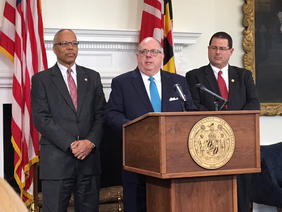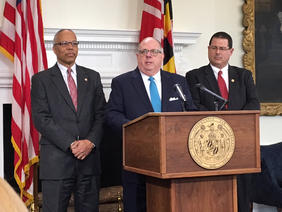Hogan Vows Veto if Bill to Limit Powers of Bd. of Public Works Moves Forward

A proposal to strip school construction decision-making authority from the Board of Public Works has Gov. Lawrence J. Hogan Jr. (R) promising prompt use of his veto power.
“It’s outrageous,” Hogan said at a news conference Monday. “Probably one of the worst ideas I’ve ever heard of coming out of Annapolis.”

Photo by Bruce DePuyt
The move to shift decision-making for school construction and modernization from the BPW to a revamped Interagency Committee on School Construction, backed by House Appropriations Chairwoman Maggie L. McIntosh (D-Baltimore City), reflects the legislature’s frustration with the board, which is comprised of the governor, comptroller and treasurer.
Last week, Senate President Thomas V. Mike Miller Jr. (D-Calvert) called the school construction “beg-a-thon,” at which local leaders publicly appeal for funds, an “embarrassment,” and he slammed Comptroller Peter V.R. Franchot (D) as a “chameleon” and “publicity hound.” Franchot’s alliance with Hogan has long frustrated General Assembly Democrats, but Miller’s comments last week, to Maryland Matters and The Daily Record, were his most blunt to date.
The McIntosh proposal was added to a measure that incorporated the work of the Knott Commission, which was formed to modernize Maryland’s process for allocating hundreds of millions of dollars a year. Among the panel’s recommendations: a fast-track approval process for counties with a strong track record, a requirement that every school have a maintenance plan, and some new construction financing options.
Under the proposal, the Interagency Committee on School Construction would become the Interagency Commission, a nine-member body made up of the state schools superintendent, two members of the governor’s cabinet, two members of the public, four people chosen by the legislature, with a chairman jointly chosen by the governor and General Assembly.
Hogan told reporters that the measure to modernize the school construction funding process “started out as something that had some good things in it, that we actually liked.”
“But … to take the state’s top fiscal leaders out of the decision-making process, on billions of dollars in school construction, to turn that over to an unelected, nameless, faceless committee hiding in secret, to make those decisions. … I mean, it’s outrageous,” he said.
Maryland residents are “demanding more transparency, more accountability in education and more oversight,” the governor said. “For them to remove the only oversight involved, and to try to take this away from the state leaders and give it to this group, it would be absolutely dead on arrival. We would veto it the second it appeared in front of us.”
Hogan alleged that the “commission would be made up of lobbyists and people with conflicts of interest,” though he did not elaborate.
Amazon’s Likely Role in Metro Funding
Barring the unforeseen, the Washington, D.C., area’s transit system will soon have something it has always lacked — a dedicated source of funding from its three founding partners, the District, Maryland and Virginia. And Hogan said Amazon’s search for a second headquarters likely played a role in moving the three jurisdictions to get serious about Metro’s historic funding challenges.
The e-commerce giant announced earlier this year that it had narrowed the search for an “HQ2” location to 20, down from a few hundred, with Montgomery County, D.C. and Northern Virginia all making the cut.
Metro, which has been plagued by serious mishaps and maintenance problems in recent years, has had sporadic funding for new rail cars and upkeep, but not a steady flow of revenue. Last year, the Washington Metropolitan Area Transit Authority General Manager Paul J. Wiedefeld challenged the region’s leaders to provide $500 million in annual funds, and earlier this month, Virginia became the first of the three jurisdictions to step up, pledging $154 million a year, the state’s full share under the system’s cost-sharing formula.
Last week, Maryland Matters was the first to report that legislative leaders in Annapolis were on board with Maryland’s full share — $167 million a year — a development Hogan immediately supported.
“It’s going to be a win-win,” Miller said.
At his news conference Monday, the governor said the chance to land Amazon, a global leader dangling tens of thousands of high-paying jobs, likely played a role in the historic show of support for Metro.
“I think everybody was focused on trying to fix Metro before the issue of Amazon came about, but there’s no question that one of the things that we need to do to convince a company like that to bring 50,000 $100,000-a-year jobs [to Maryland] is that people can get to and from work.”
Although company and Montgomery County officials have been cagey about where Amazon might build if they come to Maryland, it’s been widely reported that the Seattle-based firm is looking at the White Flint area.
“Something had to be done anyway,” Hogan said of Metro’s long-standing woes. “But maybe it helped bring the impetus to get other people excited about bringing Amazon to the Washington area. We have to have a functioning transit system.”
No Regret for Sharp Criticism of General Assembly
Hogan said he had no regrets for criticizing the General Assembly in the immediate aftermath of last week’s school shooting in St. Mary’s County.
Appearing alongside Sheriff Tim Cameron (R) after the shooting at Great Mills High School, Hogan called it “outrageous” that the legislature hadn’t approved measures he proposed in the wake of the school massacre in Florida. His rebuke drew a quick and angry retort from legislative leaders, who noted that the governor’s proposals were quickly scheduled for hearings even though they were filed after the deadline to submit bills.
“It’s unfortunate that while we are negotiating in good faith with his staff — as recently as yesterday — on this legislation that the governor chose the site of a tragedy to criticize the legislature on school safety issues,” House Speaker Michael E. Busch (D-Anne Arundel) said at the time.
Asked Monday if his comments could lead his measures, which would boost funding for school security, to get bogged down in election-year politics, Hogan said, “No, I think just the opposite, actually.”
“I said exactly what I wanted to say, exactly the way I wanted to say it,” Hogan said. “And I think we are now making progress.”
When Hogan’s chief legislative officer, former state Sen. Christopher B. Shank, testified before the House Ways and Means Committee last week, he caught an earful from lawmakers irked that the governor seemed to imply that he has a greater concern for student safety than they do.
“This is an issue that this committee has always treated as completely bipartisan, that this legislature has always prioritized,” said Del. Eric G. Luedtke (D-Montgomery County).
Hogan shrugged off any concern.
“I think the bill will get done,” he said. “I don’t know if that’s because of the shooting itself, or my comments, or simply timing, [but] the good news is we are now making progress in the House and Senate. That’s what’s important — not whether someone’s feelings got hurt.”




 Creative Commons Attribution
Creative Commons Attribution